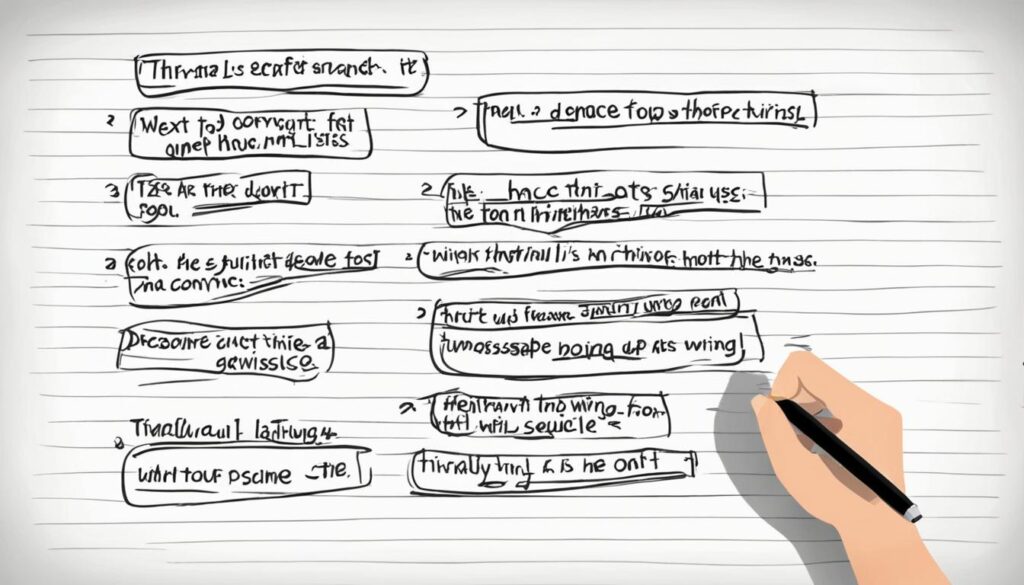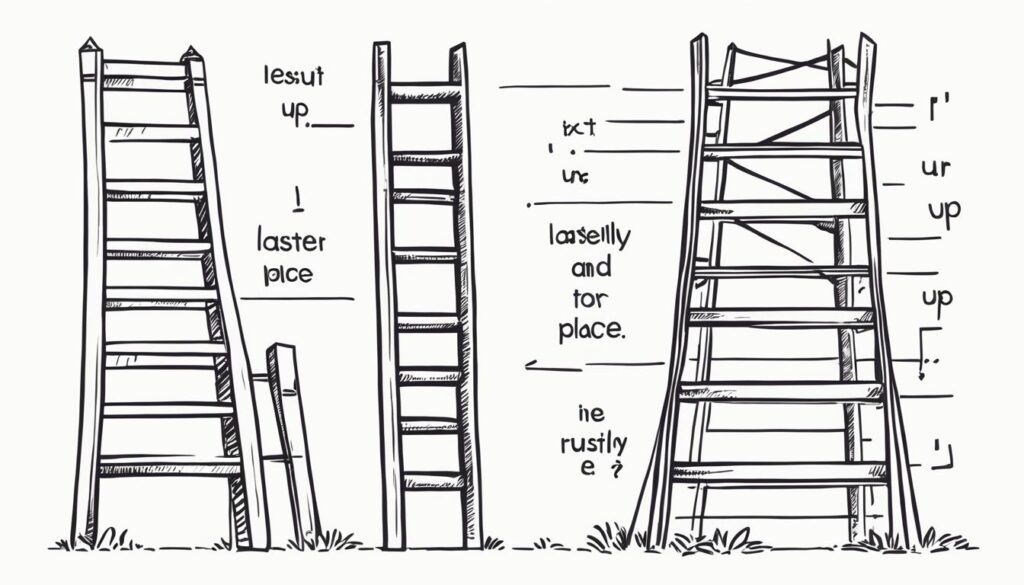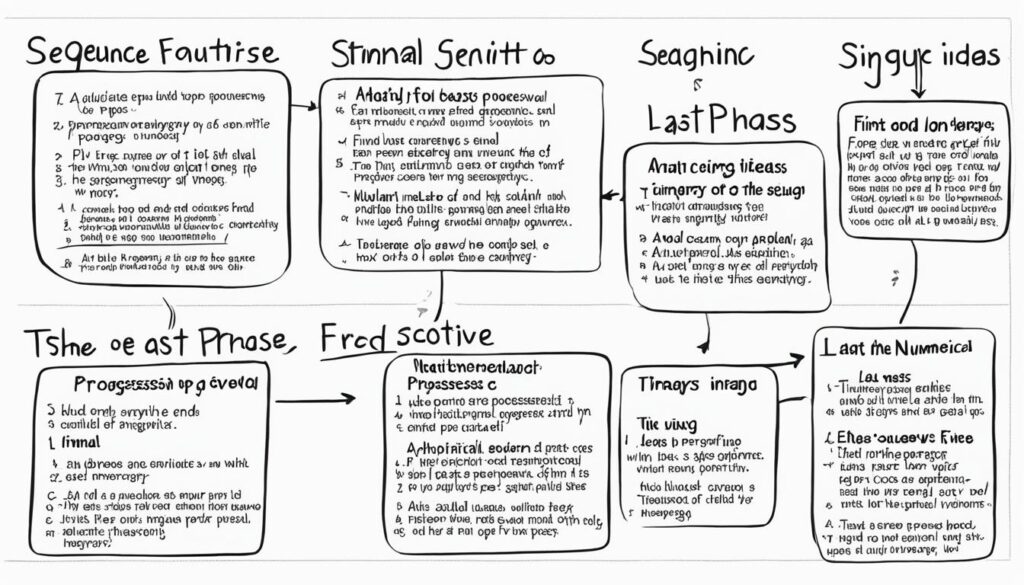I have always been a lover of words, a poet at heart. And in the realm of writing, even the most mundane tasks can be transformed into elegant prose. Today, I want to explore the artistry of sequencing our thoughts and ideas, providing alternatives to the overly used and unimaginative “firstly, secondly, thirdly.”
When it comes to organizing our writing, it’s important to strike a balance between structure and creativity. While “firstly, secondly, thirdly” may serve as functional signposts, they lack the lyrical quality that readers often crave. So, let’s embark on a journey to discover alternative phrasing that will captivate and engage our audience, creating a more memorable reading experience.
Key Takeaways:
- Replace the mundane “firstly, secondly, thirdly” with more creative and evocative alternatives.
- Consider using “first, second, third” instead, as they are more widely accepted for enumerating text in writing.
- Explore phrases like “next,” “then,” “in addition,” and “additionally” as alternatives to ordinal adverbs.
- Utilize numbered or bullet point lists for a visually appealing and effective alternative.
- For a touch of poetic elegance, consider phrases like “to begin,” “to start with,” “following from that,” “finally,” and “lastly.”
The Correct Usage of “Firstly”
In the realm of writing and language, the correct usage of words holds immense power. In the case of transitioning between points in a sequential manner, it is vital to understand the appropriate use of the term “firstly.” While “firstly” is indeed a legitimate word, experts in language and style suggest a more elegant alternative: “first.
Language aficionados such as Webster and Johnson advocate for this preference, as “first” is already an adverb without the need for the suffix “-ly.” By employing “first” instead of “firstly,” one achieves a cleaner and more concise structure, without any compromising of grammatical integrity.
One significant benefit of opting for “first” is the elimination of potentially pretentious ordinal adverbs like “seventhly” or “ninthly.” Such terms can come across as pedantic and unnecessary in modern writing. The simplicity of “first” allows for a seamless flow of thought, without encumbering the text with superfluous language.
It is essential to note that “at first” is not a suitable replacement for “firstly” or “first.” While “at first” refers to the beginning of an event or situation, it does not serve the purpose of enumerating topics in discourse. For a more refined approach to sequential phrasing, turn to the timeless elegance of “first” and let your writing effortlessly guide readers through the journey of your ideas.
The Use of “Thirdly”
“Thirdly” is often used as an ordinal adverb in writing, indicating the third point in a series. However, using this term can be seen as pretentious and may detract from the clarity of your writing. Instead, experts recommend utilizing the adverb “third” as a more straightforward alternative.
Consistency is key when using “third” in your writing. Avoid mixing it with “thirdly”, as it may confuse readers and disrupt the flow of your text. By utilizing “third” consistently, you can maintain a sense of order while avoiding pedantic language.
If you require additional options beyond “third”, you can consider using “fourthly” or the adverb “fourth”. However, it’s important to note that the adverb form of these terms is often perceived as safer and less pedantic.
“To write with clarity and elegance, I choose to use the adverb ‘third’ instead of ‘thirdly’. This not only enhances the readability of my text but also ensures that my writing maintains a sophisticated tone without being overly pretentious. Consistency is key when using these terms in your writing.”
Poetic Alternatives to “Firstly, Secondly, Thirdly”
In the art of writing, there exists a beautiful realm where words dance with elegance and sentences soar with grace. To elevate your prose and infuse it with a touch of poetic allure, consider embracing alternatives to the conventional “firstly, secondly, thirdly.” These alternatives will allow your ideas to flow seamlessly while evoking a sense of rhythm and enchantment.
Instead of commencing with “firstly,” embark on your journey with the ethereal phrase “to begin.” Embrace the delicate cadence of “to start with” as you lay the foundation of your thoughts. As you transition to the following point, let the words “following from that” guide your readers through the intricate tapestry of your ideas.
“To begin a story is to unlock a world of wonder. To start with its essence is to unravel the secrets within. Following from that, the narrative blossoms, an intricate dance of emotions and revelations.”
Finally, as you draw your narrative to a close, allow the enchanting melody of “finally” to gracefully guide your readers towards the culmination of your discourse. With the tender flourish of “lastly,” bid farewell to the realms you have ventured, leaving behind a lasting impression etched in the hearts of your readers.
These poetic alternatives to “firstly, secondly, thirdly” infuse your writing with an ethereal charm, transforming mere words into a symphony of beauty. Embrace the cadence of these poetic transition words, and watch as your prose takes flight, leaving a lasting impression on those who bear witness to its captivating dance.
Synonyms and Phrases for Sequential Phrasing
In addition to the poetic alternatives mentioned earlier, there are also other synonyms and phrases that can be used to convey sequential phrasing. Some examples include:
- “To start with”: This phrase provides a strong and clear beginning to your enumeration, setting the stage for what will follow.
- “First”: This simple and direct word signifies the initial point or reason, creating a sense of order and structure.
- “One reason is”: This phrase allows you to introduce your first point, presenting it as a distinct and significant argument.
- “Following from that”: This expression connects your preceding point with the one that follows, highlighting the logical progression of your ideas.
- “After that”: This transitional phrase smoothly transitions to the next item on your list, emphasizing its significance in relation to the previous points.
- “Second”: This straightforward word introduces the next point in your enumeration, offering a clear and concise transition.
- “The next reason is”: This phrase explicitly indicates that you are presenting another justification or argument, maintaining a structured and coherent flow in your writing.
- “Finally”: This word signals the concluding point or reason, bringing your enumeration to a close with a sense of finality and completion.
- “Lastly”: This adverb denotes the last item in your list, leaving a lasting impression on your readers and providing a sense of closure.
- “Third”: This term introduces the third point or reason, adding another layer of organization and sequence to your writing.
By incorporating these synonyms and phrases into your writing, you can infuse your text with variety and freshness, effectively avoiding the monotony and repetition associated with traditional sequential phrasing.
Common Transitional Words and Phrases
Transitional words and phrases are the magical threads that weave our thoughts and ideas together, creating a seamless and captivating tapestry of prose. Just as a skilled artist blends different shades and textures to bring their masterpiece to life, so too can we enhance the rhythm and flow of our writing with the judicious use of transitional words and phrases. These linguistic tools serve various purposes, facilitating smooth transitions between ideas, clarifying cause and effect relationships, establishing sequences, drawing comparisons, providing examples, conveying purpose, and indicating time or location. By harnessing the power of these transformative words, we can create a captivating symphony of words and captivate our readers from beginning to end.
“Consequently, therefore, accordingly…”
“Furthermore, in addition, first, second, third…”
“Similarly, although, however…”
“For example, for instance, specifically…”
“For this purpose, to this end…”
“Before, after, while, now, since…”
As we embark on our literary journey, let us dive into the depths of each transitional category to uncover their profound impact on our writing.
Cause and Effect Transition Words
When our words possess the power to elucidate the causes and effects of a situation or idea, they enable our readers to traverse the intricate web of relationships with clarity. Transition words such as consequently, therefore, accordingly guide our audience to the inevitable conclusions that arise from our discourse.
Sequence Transition Words
In the grand tapestry of life, events unfold one after another, forming a coherent sequence that binds us all. Transition words like furthermore, in addition, first, second, third serve as the delicate threads that stitch our ideas together, ensuring a smooth transition from one point to the next.
Comparison Transition Words
Just as a masterful painter juxtaposes colors and shapes to convey contrasting moods or perspectives, we can use comparison and contrast transition words to highlight differences or similarities in our writing. Whether we choose similarly, although, however, or other such phrases, our words will guide our readers through a maze of divergent thoughts, fostering a deeper understanding of our ideas.
Example Transition Words
Examples have the power to illuminate abstract concepts and breathe life into our writing. By using transition words like for example, for instance, specifically, we can craft vivid illustrations that resonate with our readers, allowing them to grasp the essence of our arguments.
Purpose Transition Words
Every word we write serves a purpose, contributing to the greater narrative we seek to convey. With the aid of purpose transition words like for this purpose, to this end, we can steer our readers towards a deeper understanding of why we crafted our words, aligning their thoughts with our intended intentions.
Time Transition Words
Just as time flows ceaselessly, so too must our writing possess a sense of temporal order. By employing transition words such as before, after, while, now, since, we guide our readers through a journey that unfolds in a logical and coherent manner, ensuring that each word falls into its rightful place on the page.
To Begin, Following On From That, Finally
Formal writing requires the use of proper transitional phrases to convey a logical sequence of ideas. Instead of relying on the overused “firstly, secondly, thirdly,” I often turn to the sophisticated combination of “to begin, following on from that, finally.” This trio of phrases elegantly guides the reader through your points in a specific order, enhancing the overall flow of your writing.
When crafting academic essays, it is essential to explain your thought process or present information in an organized manner. The transition from one point to another can be seamless with the use of “to begin” as the initial step. This phrase allows you to introduce your first idea confidently and sets the stage for what follows.
Moving on, “following on from that” serves as a smooth transition between points. It highlights the logical progression of your thoughts, emphasizing the link between each idea. This phrase effectively connects your ideas, ensuring that your readers can easily follow your train of thought.
Finally, “finally” acts as a strong concluding transition that indicates the last point of your sequence. This phrase wraps up your discussion, signaling that you have reached the end of your argument or presentation. It provides closure and helps your readers make sense of the overall structure of your writing.
Incorporating this combination of formal transitional phrases – “to begin, following on from that, finally” – adds sophistication and variety to your writing, avoiding the repetitiveness of typical enumerations. By alternating between these formal sequence transition words and more traditional phrases, you can engage your readers and maintain their interest in your essay or research paper.
To Start With, After That, Lastly
“To start with, after that, lastly” is a delightful departure from the conventional “firstly, secondly, thirdly” in writing. While it may not be a perfect fit for scholarly papers, this informal and conversational alternative is perfect for injecting a touch of engagement and liveliness into formal essays. It offers a fresh and captivating approach to presenting multiple points in a specific order.
Conclusion
In concluding, the use of mundane phrases such as “firstly, secondly, thirdly” in writing can be perceived as pedantic and uninteresting. Why not explore more enchanting alternatives like poetic expressions, diverse synonyms, and graceful transitional words to elevate your prose and maintain a seamless sense of order and sequence? Whether you opt for formal or informal transitional phrases, it is essential to consider the tone and purpose of your writing, ensuring it resonates with your audience. Embrace the opportunity to experiment with different alternatives, discovering those that best suit your personal style and effectively convey your ideas.
Let us bid farewell to the monotonous routine of “firstly, secondly, thirdly” and embrace a more captivating and imaginative approach to presenting a series of points. By incorporating poetic phrases that stimulate the reader’s senses, choosing vibrant synonyms that enliven your language, or seamlessly transitioning with purposeful, vivid words, your writing will flourish with creativity and originality. Leave behind the shackles of rigid structure and embrace the freedom of expression that alternative sequencing offers.
In essence, the possibilities are endless when it comes to exploring alternatives to the tired and repetitive phrasing of “firstly, secondly, thirdly.” Take this opportunity to infuse your writing with vitality, grace, and elegance. As a writer, it is within your power to experiment with diverse sequential phrasing approaches, adding depth and sophistication to your work. So, go forth and break free from the limitations of traditional enumeration, and craft your sentences with a touch of poetic charm, breathing new life into the art of expression.
FAQ
What are some alternatives to using “firstly, secondly, thirdly” in writing?
Some alternatives include using “first, second, third,” “to begin, to start with, to follow that,” and “finally, lastly.”
Is it incorrect to use “firstly” instead of “first”?
While “firstly” is a real word, it is considered incorrect by many language experts who recommend using “first” instead.
Are there any alternatives to using “thirdly” in writing?
Yes, alternatives include using “third,” “fourthly,” and the adverb “finally.”
Can I use poetic phrases as alternatives to “firstly, secondly, thirdly”?
Yes, you can use phrases like “to begin, following on from that, finally” to add elegance and poise to your writing.
Are there other synonyms I can use for sequential phrasing?
Yes, alternatives include “to start with,” “one reason is,” “following from that,” “after that,” “second,” “the next reason is,” and “third.”
What are some common transitional words and phrases that can aid in sequencing?
Common transitional words and phrases include “consequently, therefore, accordingly,” “furthermore, in addition, first, second, third,” “similarly, although, however,” “for example, for instance, specifically,” “for this purpose, to this end,” and “before, after, while, now, since.”
Can I combine formal transitional phrases to list points in order?
Yes, you can combine phrases like “to begin, following on from that, finally” to effectively list points in a specific order in formal writing.
Are there informal transitional phrases I can use instead of “firstly, secondly, thirdly”?
Absolutely, alternatives like “to start with, after that, lastly” provide a more conversational tone and work well in many formal essays.
What are some final thoughts on using alternatives to “firstly, secondly, thirdly”?
By exploring alternative phrases, synonyms, and transitional words, you can bring richness and variety to your writing while maintaining a sense of order and sequence.
Source Links
- https://grammarist.com/usage/firstly-secondly-thirdly/
- https://wordselector.com/other-ways-to-say-firstly-secondly-thirdly/
- https://web.mit.edu/course/21/21.guide/tran-cwp.htm














